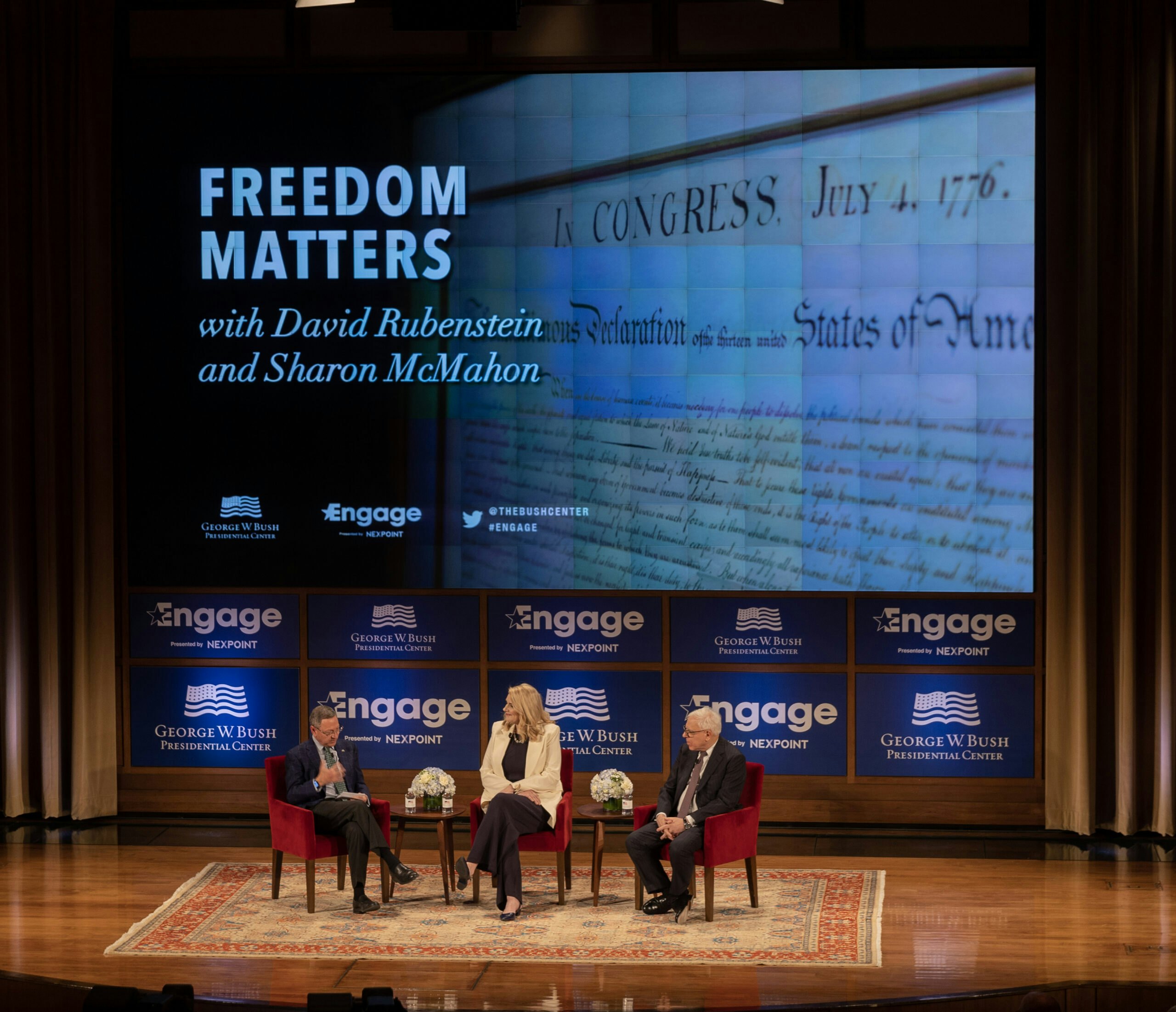As part of a summer-long look at baseball and the larger American society, the Bush Institute is interviewing a range of people who follow the...
As part of a summer-long look at baseball and the larger American society, the Bush Institute is interviewing a range of people who follow the sport closely. We are doing this at the same time that the George W. Bush Presidential Museum and Library is hosting the special exhibit,“Baseball: America’s Presidents, America’s Pastime.” The exhibit runs through October 4, 2015 and features baseball documents and artifacts from a variety of presidential libraries.
In this interview, we talk with Dale Petroskey, who served as president of the National Baseball Hall of Fame and Museum in Cooperstown, New York from 1999 to 2008. During his tenure, the museum launched the traveling exhibition, Baseball as America, which was seen by more than 2 million people across the U.S.
After his time in Cooperstown, Petroskey joined the Texas Rangers as executive vice president for marketing and community development. Now the president and CEO of the Dallas Regional Chamber, Petroskey shares in this interview his thoughts about Americans’ relationship to baseball.
You’ve seen many Americans make the trek to Cooperstown, which takes some effort to reach. In your estimation, what connects baseball to the larger American society?
Yes, for nearly nine years, I saw millions of fans from all over the United States and the world make the pilgrimage to Cooperstown, the beautiful little village of 2,300 residents in upstate New York. It was heartwarming; most who visited have a deep connection to baseball, and the game resides in the deepest reaches of their being.
One reason that baseball is so connected to American society is that it got a big head-start on every other professional team sport. Until post-World War II, the only other sports it competed with were college football, horse racing, and boxing; they were hardly competition for a sport played – and written about and broadcast – every day for six months a year to a nationwide audience. Baseball was the one true American team sport and it was upon that foundation that generation after generation of fans was built.
Another reason for its wide appeal is that it has something for everyone. On one end of the spectrum, casual fans love going out to the ballpark on a sunny day and having a hot dog and beer with friends; on the other end, some turn every at-bat, game, and season into a doctoral thesis in mathematics. And there’s room for every variation of fan in between.
I also believe one of the allures of baseball is that it’s played in the summer – when school is out, and in earlier days in between the hard work of planting and harvesting the crops. The pace of life in summer is generally more leisurely and fun – and so we associate baseball with sunshine, a slower pace, and fun.
And most importantly from a social standpoint, because Americans inherently believe in fairness and opportunity for all, the day Jackie Robinson stepped onto Ebbetts Field – April 15, 1947 — was one of the most important days in American history.
That moment demonstrated things were changing in America. It was now about the ideal of opportunity for all, and that one would be judged based on performance when given the chance. Americans have never forgotten that baseball led the way in fulfilling that American ideal, and I think that’s an important reason baseball still makes such a connection for so many Americans.
But how does the sport maintain that connection? The world in which we live puts a premium on speed, doing two-things-at-once and instant returns on time invested in an endeavor. How does baseball compete with our frenetic pace?
Baseball is maintaining that connection; it’s in great shape today.
Nearly 74 million people attended major league games last year, one of the highest figures in history. More people than ever followed their teams on TV, radio, or the internet. MLB franchises have never been worth more. TV contracts have never been higher. And the game on the field has never been played by better athletes.
Yes, lots of youngsters are into video games or other sports these days, opportunities that may not have been available decades ago, but our U.S. population has doubled in the past 50 years, so there are still lots of Americans who follow baseball and play baseball. Believe me, elite high school or college players — the gifted youngsters who are being watched by pro scouts and have a chance to be the next professionals – have never been better.
I also believe the new technology devised by MLB.com for tablets and phones has allowed real fans to understand – and appreciate – the game at a much deeper and more interesting level than ever before.
You mentioned Jackie Robinson and the importance of the day he stepped onto Ebbetts Field. It signaled change was underway in America. Today, we see another change happening in baseball. Latino ballplayers are becoming a strong force in Major League Baseball. How do you see this trend playing out? Are we likely to have international leagues someday?
It’s so exciting to see the talent level in the major leagues today because players are now coming from all over the globe, including Latin America, Asia, and even some from Australia. It’s a better game when talent can come from every corner of the globe.
I’ve been to the Dominican Republic and Puerto Rico and seen first-hand the passion they have for the game. They start as young boys and develop their skills by playing all day, every day. Their dream is to reach the major leagues, and what’s different about today’s Latino players is that they have role models – Juan Marichal, Roberto Clemente, Robbie Alomar, Pedro Martinez, Tony Perez – who not only made it to the big leagues, they were among the one percent of major leaguers elected to the Hall of Fame, baseball’s highest honor.
I think some of that fuels the passion in Latin America today – the fact that their path has been paved by the greats who showed them the way and what is possible for them.
Novelists, historians, filmmakers and others have long written about the sport. You have a communications background. Any theories about why we see this with baseball but not particularly football or basketball?
Great question. I think it’s mostly because baseball is a metaphor for life. Life is filled with successes and failures, and lots of ambiguity in between. The 30 major league teams play 162 games a season, and the best team usually wins about 100 games; the worst team usually wins about 60. That means 30 teams are separated by 40 games over a 6-month season – razor thin, when you think about it.
A bloop single can make a season; a key injury can break a season. That’s a lot like life; we give it our all every day and sometimes things out of our control determine our fate – either positively or negatively.
I also believe it’s because baseball is really mostly about human relationships. When you think about it, we’re often taught to love the game by our parents or grandparents, and we pass down that love to our children or grandchildren. Just about every time we go to a game or watch a game on TV, we’re with family or friends. That’s why storytellers like to use baseball as the background for telling great stories about human relationships, or what’s happening in society at a particular moment in time.
And lastly, I think it’s because baseball lends itself to storytelling more than football or basketball. Most fans don’t truly understand what’s happening with all 11 players on offense or defense on each down in a football game. Same in basketball; the average fan cares about whether a shot goes in or not, but doesn’t really understand the intricacies of what’s happening on the floor.
Baseball is an open book, and a chess match. Knowledgeable fans – and I believe there are many more knowledgeable baseball fans than in football or basketball — can easily see everything happening on the diamond and manage right along with the manager. When you can understand the game at that level, detailed stories can be passed down about a particular at-bat, play, inning, game, or series. Or about particular teams, players, or moments.
Generally speaking, true baseball fans can understand and communicate what they’ve seen in a way that football and basketball fans can’t.
























